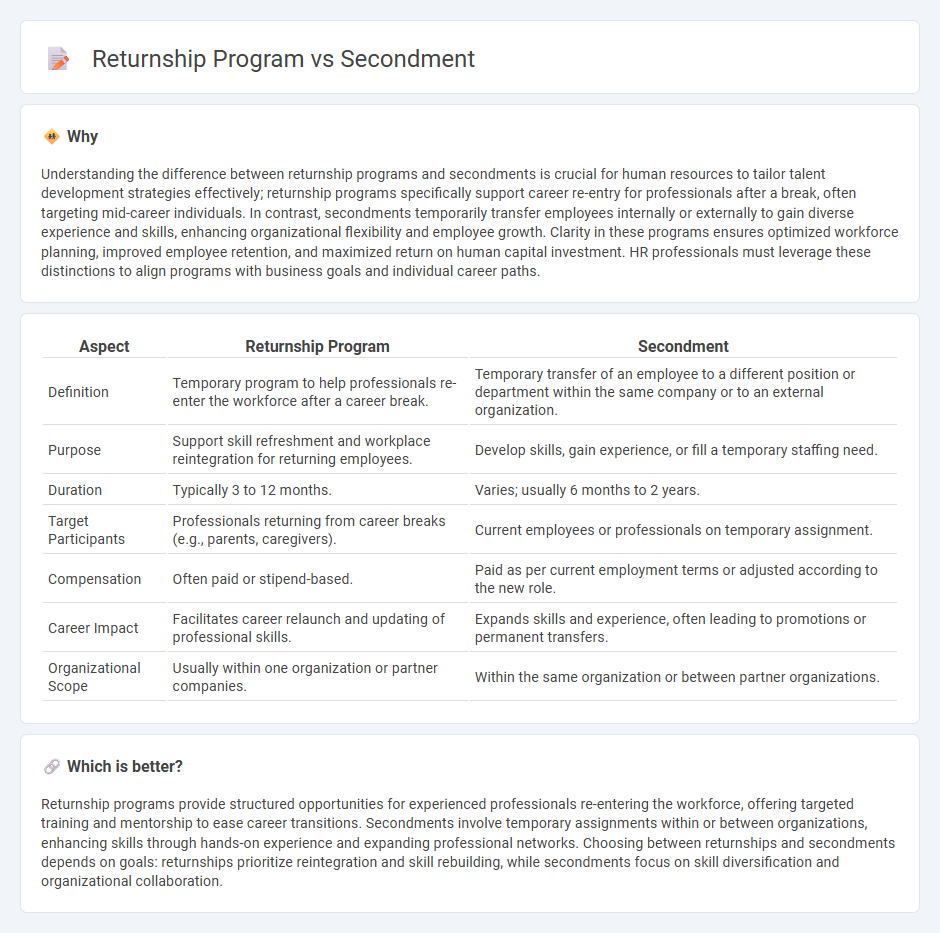
Returnship programs provide structured opportunities for professionals re-entering the workforce after career breaks, focusing on skill refreshment and reintegration. Secondments temporarily assign employees to different roles or departments, enhancing their experience and organizational knowledge. Discover how these strategic HR initiatives boost career development and talent retention.
Why it is important
Understanding the difference between returnship programs and secondments is crucial for human resources to tailor talent development strategies effectively; returnship programs specifically support career re-entry for professionals after a break, often targeting mid-career individuals. In contrast, secondments temporarily transfer employees internally or externally to gain diverse experience and skills, enhancing organizational flexibility and employee growth. Clarity in these programs ensures optimized workforce planning, improved employee retention, and maximized return on human capital investment. HR professionals must leverage these distinctions to align programs with business goals and individual career paths.
Comparison Table
| Aspect | Returnship Program | Secondment |
|---|---|---|
| Definition | Temporary program to help professionals re-enter the workforce after a career break. | Temporary transfer of an employee to a different position or department within the same company or to an external organization. |
| Purpose | Support skill refreshment and workplace reintegration for returning employees. | Develop skills, gain experience, or fill a temporary staffing need. |
| Duration | Typically 3 to 12 months. | Varies; usually 6 months to 2 years. |
| Target Participants | Professionals returning from career breaks (e.g., parents, caregivers). | Current employees or professionals on temporary assignment. |
| Compensation | Often paid or stipend-based. | Paid as per current employment terms or adjusted according to the new role. |
| Career Impact | Facilitates career relaunch and updating of professional skills. | Expands skills and experience, often leading to promotions or permanent transfers. |
| Organizational Scope | Usually within one organization or partner companies. | Within the same organization or between partner organizations. |
Which is better?
Returnship programs provide structured opportunities for experienced professionals re-entering the workforce, offering targeted training and mentorship to ease career transitions. Secondments involve temporary assignments within or between organizations, enhancing skills through hands-on experience and expanding professional networks. Choosing between returnships and secondments depends on goals: returnships prioritize reintegration and skill rebuilding, while secondments focus on skill diversification and organizational collaboration.
Connection
Returnship programs and secondments both serve as strategic talent management tools in Human Resources, designed to enhance employee skills and career development. Returnships provide opportunities for professionals re-entering the workforce after a career break, often through time-bound placements that help rebuild confidence and update skills. Secondments involve temporary transfers to different roles or departments within or between organizations, facilitating knowledge exchange and broadening employee expertise, which complements the re-skilling focus of returnship programs.
Key Terms
Temporary Assignment
Temporary assignments through secondment programs enable employees to gain specialized skills and cross-departmental experience by working in a different role or organization for a set period. Returnship programs, designed primarily for professionals re-entering the workforce after a career break, offer structured, time-limited opportunities to refresh skills and rebuild professional networks. Explore our detailed comparison of secondment and returnship programs to understand which temporary assignment best suits your career goals.
Career Reentry
Secondment programs offer temporary assignments within or between organizations, enhancing skills and network expansion for career progression, while returnship programs specifically support professionals reentering the workforce after career breaks, often in structured, part-time roles with mentoring. Both initiatives facilitate career reentry but target different stages and objectives, with secondments emphasizing skill diversification and returnships focusing on reintegration and confidence rebuilding. Explore more insights on how these programs can strategically boost your career reentry journey.
Skill Development
Secondment programs enable employees to temporarily work in different roles or departments, fostering skill development through hands-on experience in diverse business functions. Returnship programs target professionals re-entering the workforce after a career break, offering tailored training and mentorship to update skills and rebuild confidence. Explore how these programs uniquely enhance talent growth and bridge skill gaps.
Source and External Links
What is a Secondment? | HR & Payroll Glossary - Paylocity - Secondment is a temporary work arrangement where an employee is reassigned to a different role within their organization or with an external partner.
What Is Secondment? Meaning + Examples - Velocity Global - A secondment is a temporary work arrangement where an employee is assigned to a different organization, department, or location while maintaining employment with their original employer.
Secondment - Wikipedia - Secondment is the temporary assignment of a member of one organization to another organization, often for professional development or collaboration purposes.
 dowidth.com
dowidth.com